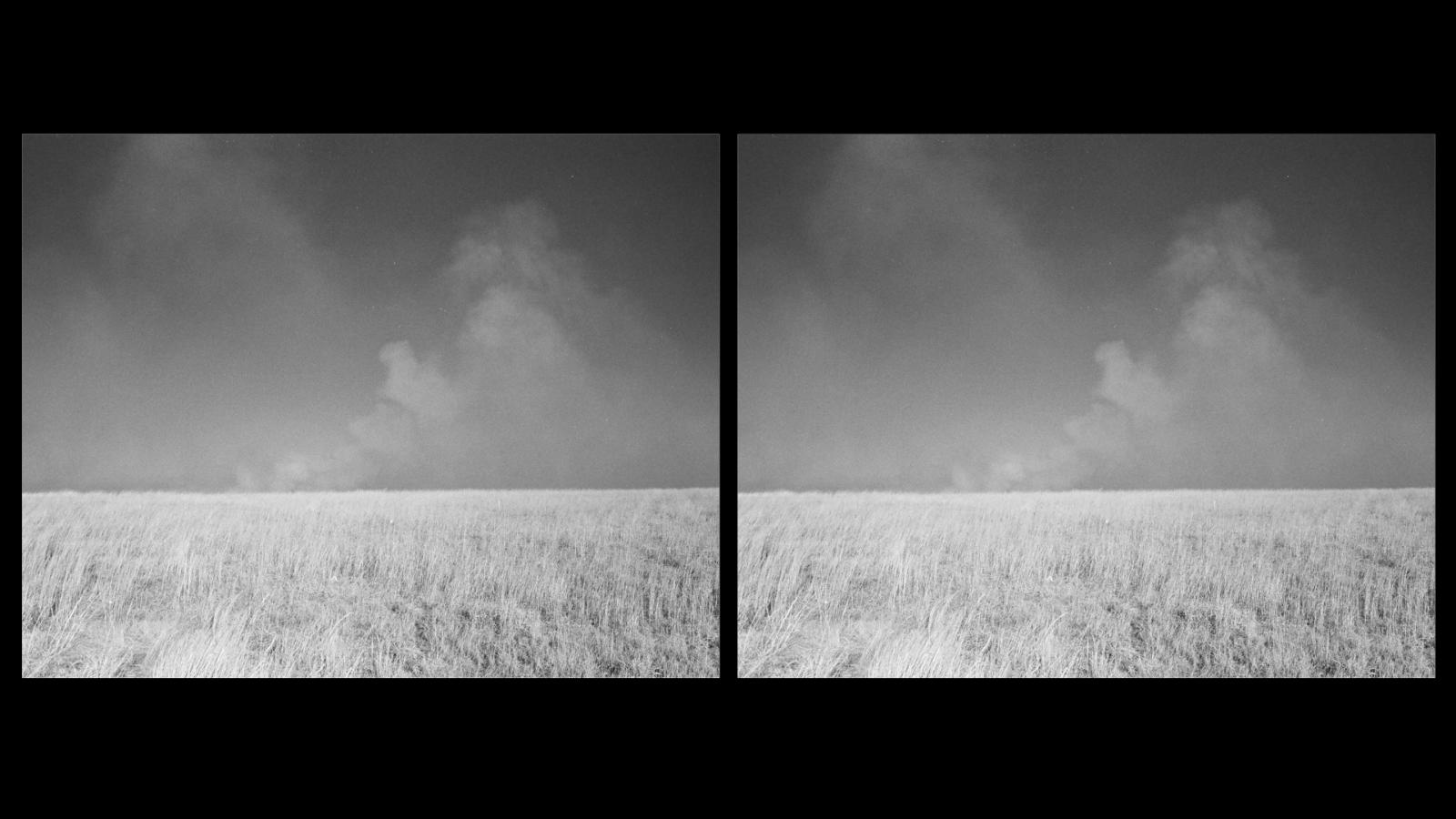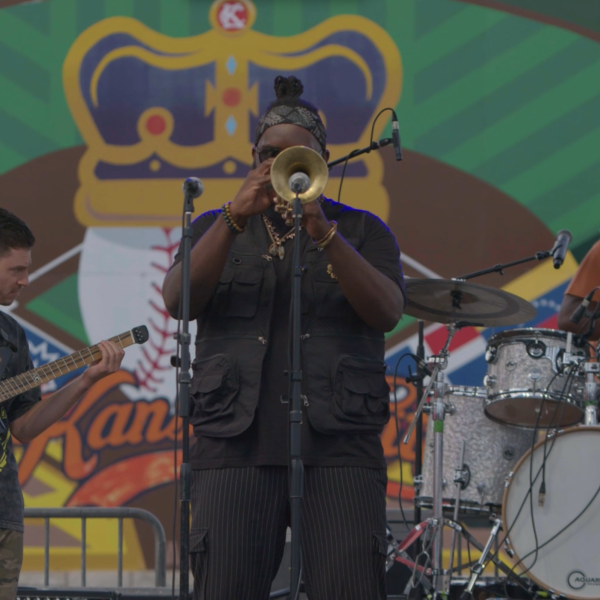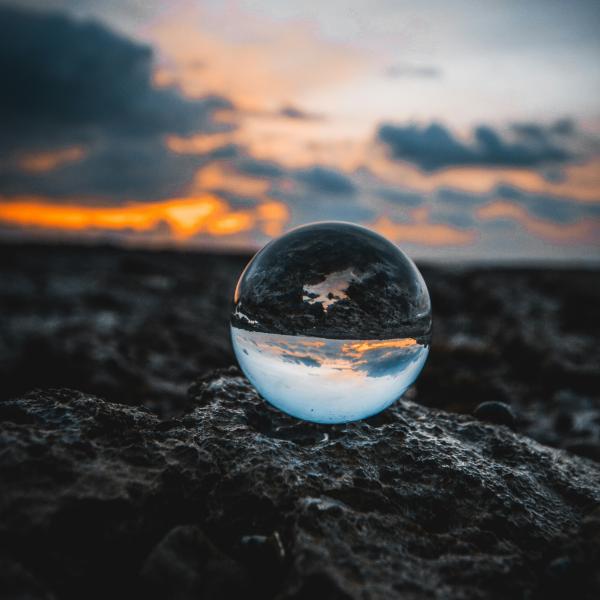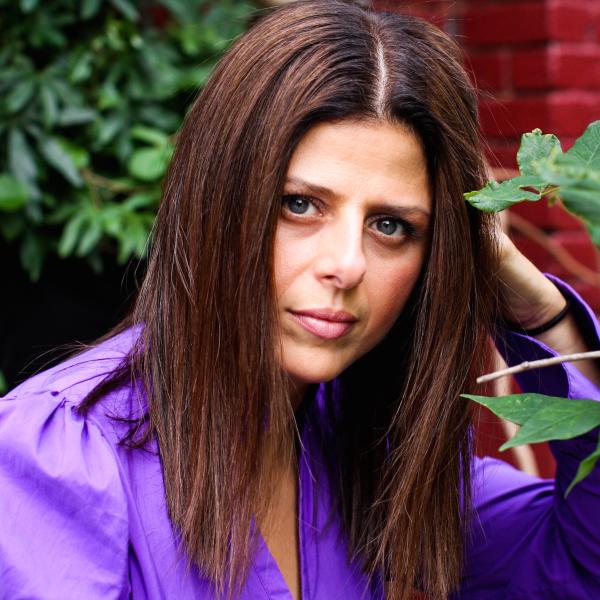Five Questions with Keli Mashburn & Marcella Ernest

There is a common, longstanding misconception that Native American art is synonymous with traditional art—beadwork or weaving for example. And yet, as the exhibition materials for Transformer: Native Art in Light and Sound, state: “This limiting interpretation does not recognize that tradition, by its very definition, is not static but is in a constant state of motion.”
This cultural motion is on display in Transformer, on view through January 6th, 2018, at the New York campus of the National Museum of the American Indian (NMAI). The show focuses on ten artists whose work incorporates light, digital projection, and experimental media—artistic tools that demonstrate the continued evolution of Native cultural expression. We recently spoke with two of the exhibition’s featured artists: photographer Keli Mashburn (Osage) and film and sound artist Marcella Ernest (Ojibwe), longtime friends who collaborated on the beautiful, disorienting film Ga.ni.tha, which mixes photographs of the Oklahoma landscape with audio and video of ceremonial dances, song, and prayer. Our conversation below has been edited and condensed.
NEA: What were you trying to achieve with Ga.ni.tha and what was the creative process in making it?
MASHBURN: I see what’s called Native art, and I see there are these themes that are shared throughout Native art. I got tired of the narrative of basically: “You guys are pitiful and you lost everything and genocide—get over it.” I’m tired of that narrative and I encounter it in every community I go to. Just being present in a room, I’m ruining people’s days because I don’t have on feathers. It’s really exhausting disappointing everyone all the time.
So when I look at art, I was tired of the same old angry or sad stuff. I didn’t want to express anger and I didn’t want to express regret. What I wanted was to dispel myths. What I wanted to put out there is something beautiful and something positive. The way I did it was by using landscapes and the metaphor of the most destructive thing, arguably on the planet, which is out-of-control wildfires. If you look at the film, it’s about chaos. You see this landscape. We can all relate to it, because we all live on Earth, we all have to walk on the ground, we all see the sky, we know that water exists. So you see these elements. [The film is] very simple, not much to distract you. What I’m focusing on is what has made it through that chaos. I think the perfect metaphor is that fire. It can either be the worst thing or it can be the best thing. You see the destruction; you see the smoke behind the hill. You can never put your finger on it, but you know it’s happening—it’s cycles of nature, and how do we relate to that?
If you can sit through that four minutes and feel anything at all, we’ve accomplished our goal. It was designed so that you can and you want to and it’s over before you know it. You don’t know what you just learned, because that’s a very Native way to transfer knowledge. It’s there. You don’t know how, but something is there and it will grow.
NEA: There is a misperception or stereotype that “Native art” means art that uses traditional materials or practices. Why do you think that stereotype persists—that Native art cannot be contemporary?
MASHBURN: I think that it’s cognitive dissonance, like I’m not behaving like someone from the 1800s like I ought to. We are in this place where we’re not allowed to be anything. We have to be brown. We have to have black hair. We have to wear turquoise. We have to pray with cedar. People assume they know everything because of all the Hollywood movies.
We’re actually living in contemporary times next door to everyone. We’re here. There’s this narrative in the United States about Manifest Destiny, and we conquered this, we conquered that. No one’s really trying to know the history [of Native people]. You don’t want to talk about the negative things. It’s exhausting, because it’s such a heavy thing.
So anytime a Native does anything, if it’s not with feathers or dancing, you know, or crying about pollution, it’s “That’s not what you’re supposed to do;” “That’s not how you are.” It’s like America’s written and closed the book.
ERNEST: I think there’s something really healing about art, and particularly experimentalism because it is so complicated and there are so many layers. Working in the experimental genre, for me anyway, is the only way to get to the nuances of the complexities of not just being Native American in the United States, but of the history of America itself as a colonizing empire.
But with experimental media and something like Ga.ni.tha, we’re able to add so many different layers where in each viewing, you’re picking up on different things. Maybe, hopefully, each person walks away with a different feeling or different emotion that encourages that individual or that group to go out and educate themselves more. That doesn’t mean educate yourself in a book. [It’s about] asking questions so we can open up dialogues that are meaningful and important so that we can address the things that Keli was just explaining.
Like she said, if we’re not talking about it because the book is written and closed, then that’s a really dangerous and violent place for all of us to be in. When these issues of race and violence and this America are not addressed, there becomes so much angst and aggression that things explode and implode—emotionally, physically, mentally.
But I do agree with Keli that since the inception of America, popular culture has had a huge influence on the way this country has been designed, where Native Americans were taken on the road as circus and sideshow exhibits and exhibited with animals. Arguably, [that] still exists today through Hollywood, where we’re still being exhibited throughout the world.
That’s what I love about the show that NMAI has put together. I hope that it does make people want to go and ask more questions and seek answers, because they’re not getting this sepia tone Edward Curtis-esque [work]. I think that we’re at a time now where this exhibit is of the utmost importance.
NEA: Since this exhibition is explicitly about Native art, I was curious about how both of you define Native art?
MASHBURN: I really don’t [define it]. I’m aware that there is this Native art; I’m aware of the tropes. Like I said, I try to avoid them. But I don’t really define myself or others like “This is Native and that’s not Native.” I really try to see art as art. It doesn’t matter if you’re Native or Nigerian or Caucasian. I think great art doesn’t have to be prefaced.
ERNEST: What comes to mind is this great quote from Jean-Michel Basquiat. It’s something where he’s asked about how it feels to be a black artist, and he said, “I don’t know. I don’t paint with just black.” I read that at a very early age, maybe high school, and it occurred to me that Indian art doesn’t have to be something specific. It doesn’t have to contain all of these tropes of feathers and sunsets and things like that. So to answer your question, I would think that Native art would hopefully be something that was created by a Native person. I think it’s that simple. I don’t mean that that person has to be enrolled by the federal government. I just mean somebody who identifies as a Native person or maybe somebody who has lineage to a Native community. My little girl is five and she comes home every day with a backpack full of Native art.
NEA: The title of the exhibition is Transformer in part because artists are cultural transformers, according to the exhibition text. How do you see yourselves as transforming culture?
MASHBURN: I think it’s more of an illustration of continuity. The things that we’re doing today are things that we did 1,000 years ago. We’re expressing the same sort of ideas but in a modern context. Our worldview for the most part remains intact. That’s one thing I can say about my Osage people. I’m reading a book that was written in the 1800s, and I can see those attitudes and those modes of thinking and those behaviors today.
But we’re constantly evolving. Time marches on. We’re still here. Of course we’re going to transform with the times. I like the idea of transformers because I hope what Transformer is doing is transforming the perception of us. We need to get past this whole [idea of] you guys don’t live in teepees? You guys don’t drive covered wagons? We get asked that stuff. It is crazy. We have cars. We’re modern. What I want to come across is of course we’re modern. We’ve been here alongside you the whole time. We’re not some fantastical creature. We’re people. We're moving forward through time and we’re on the same timeline as you guys. So I like to think of the Transformer title as transforming the American ideal of what a Native is or should be. We’re transforming that simply by expressing ourselves with modern tools.
ERNEST: I think what this show accomplishes is this huge act of decolonization by using technology. Our piece specifically remixes sound and images and intellectual thoughts to powerfully transform this whole history of ethnography and other mainstream representations.
[Tsu Heidei Shugaxtutaan 1 and 2] by Nicholas Galanin in this show is a good example of using remix to powerfully transform these early concepts of ethnography and other mainstream representations from their original intention into powerful political sites for public communication. If you take the time to learn and see and feel in these spaces [like NMAI] through these representations, then you’re taking those concepts and these things that we’ve grown up knowing out of that original intention, and you’re moving it into this powerful political site for public communication. Maybe that’s what NMAI does.
NEA: A huge part of Ga.ni.tha revolves around the landscape. How do you view the intersection between landscape and culture?
ERNEST: Indigenous communities are so ingrained in the land. It’s articulated in our art, language, identity. I don’t think you can take Native people out of concepts of land in most situations.
MASHBURN: It's inseparable because a culture doesn’t exist without a landscape. If there’s nothing to live on, you’re not going to live. I think it’s the common denominator. There is this idea that we’re this and you’re that; this whole “us” and “them” idea. I think what really bonds us and holds us all together is that we are all part of the landscape.
[Native communities] never had this idea of “We will conquer this.” We were more symbiotic, I suppose, more holistically a part of [the landscape]. It’s more looking at the system as a whole and working within that system with the full knowledge that we are an integral part of it. You can’t separate Natives from the land. And you can’t separate the Western idea of conquering the land from Natives. None of that is addressed in the film directly but it’s all there. Those things are always going to be there. But we can transform the perspective, and the way you come to it and see it and hopefully we can all come out better for it. It’s very difficult. It’s hard. People get angry. People feel guilty. It’s just a very difficult conversation to have but it’s necessary. And it is ultimately rewarding if you can get through it.




